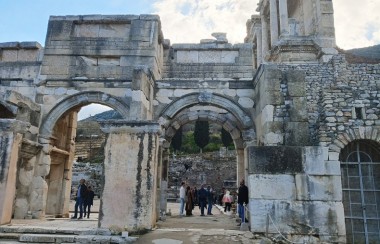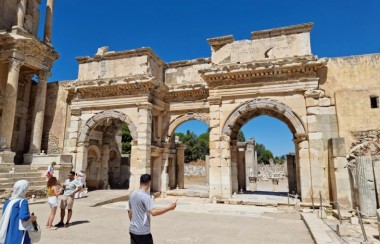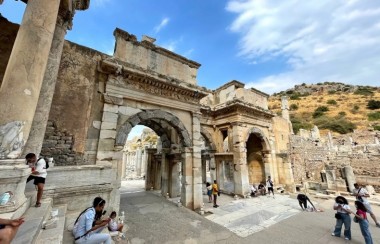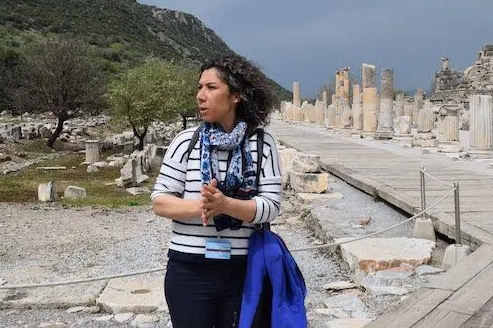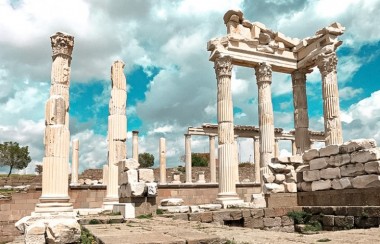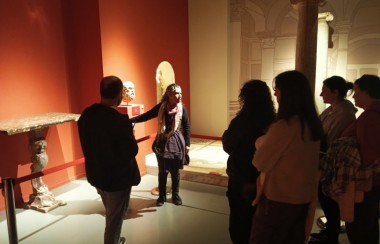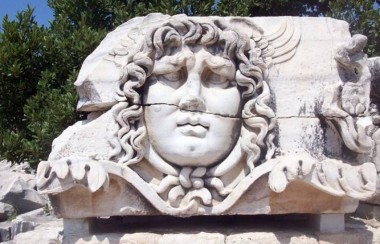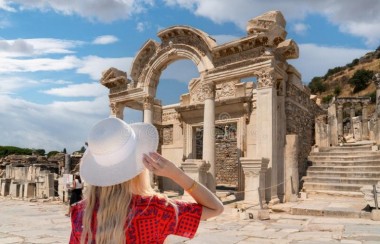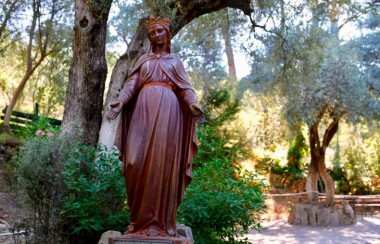The Commercial Agora had three main gates, enabling access from the north onto Harbour Street, the south-east, and the west. The most impressive and best-preserved of these gates is the so-called Gate of Mazaeus and Mithridates on the south-eastern side, very close to the Celsus Library. This monument is also the only large-scale structure of the Augustan building programme that survived the earthquake of 23 CE.
The Gate of Mazaeus and Mithridates has three arched openings, and the central opening recedes by 1.5 meters. The gate's façade is beautifully decorated with floral motives. The portal is an excellent example of the donation of a public building by private persons. The gate features three main inscriptions over its arches: on the sides, there are Latin texts, but the central text is in Greek. They inform that the gate was erected by two freedmen of Octavian Augustus and Marcus Agrippa, called Mazaeus and Mithridates. As a gravestone found in Ephesus states that Mithridates was the freedman of Agrippa, Mazeus must have been the one manumitted by Augustus. Thankful for the manumission, they had this gate built in the honour of Octavian Augustus, his wife Livia, his son-in-law Marcus Agrippa, and Julia the elder, the daughter of Augustus and the wife of Agrippa. The titles given to Octavian Augustus allowed dating the gate to the years 3-4 BCE. In this time, Agrippa had been dead for nine years and his widow, Julia, remarried to Tiberius. Thus, the inscription, in a delicate diplomatic manoeuvre, calls her "the daughter of Augustus" instead of mentioning her husbands.
Originally, these inscriptions were made of gold-plated bronze letters, but only their sockets can be seen today. The Latin and Greek versions are different, while the Greek text claims that the gate had previously been dedicated the Ephesian "demos" (the people), the Latin texts do not use this formula. The Latin inscription on the left arch mentions Augustus, and the inscription on the right arch is for Agrippa. Each freedman's name is given on the part of the gate dedicated to their patrons, respectively. Moreover, the analyzes of the style of the decorations of the left and right parts of the gate indicated that different teams of sculptors had been responsible for their production. There are additional inscriptions below, informing about price edicts and grain supply, too. The vault from the side of the Library of Celsus is lined with black marble, in contrast to the vault on the opposite side, lined with white marble. It is possible that the gate was also a memorial monument for Mazaeus and Mithridates who may have been buried in the annexes of their parts of the gate, as indicated by an inscription found nearby.
Archaeological excavations carried out in the area of the gate offer us an opportunity to conclude that the ancient architects and builders also made mistakes and encountered construction problems. In the case of the gate, it was originally designed to be used by vehicles and its original floor was on the same level as the Commercial Agora and the square where the Library of Celsus was erected one century later. However, this solution caused the problem with the rainwater that flowed freely from the paved square and covered the Commercial Agora with mud. Thus, the need arose to rectify this situation, and a drainage pipe was added below, discovered in the 1903 excavations. The system of pipes collected the rainwater and transported it to the sea. Moreover, the level of the gate floor was raised, and it was no longer possible to pass it in a carriage.
The ancient gates were problematic places to keep clean, as it also happens nowadays. An inscription found near the Gate of Mazaeus and Mithridates informs that "Whoever urinates here will be punished". What kind of punishment was on offer remains a mystery. Obviously, not everyone made it to the public latrines or found a bucket that served as a public urinal on time. The contents of these urinals were collected and bought by the fullers who used them for cleaning textiles.
The present state of the Gate of Mazaeus and Mithridates is the result of the restoration project that was carried out between 1980 and 1989. Importantly, the southern façade was fully restored with the almost exclusive use of the ancient building materials.
Related Shore Excursions
Explore Ephesus History with our Shore Excursions .
Pergamum & Asklepion
The Acropolis and the Asklepion of ancient Pergamum, both listed among the top 100 historical sites...
Priene, Miletos & Didyma
The God’s Sanctuary, Didyma, was not a city, but one of the three places of the oracles
Discover Majestic Ephesus
Majestic Ephesus takes you on an unforgettable journey through history; etched on minds as the...
House of Virgin Mary, Ancient City of Ephesus, Basilica of St.John
Ephesus played an important role in the spread of Christianity. Ephesus is&...

